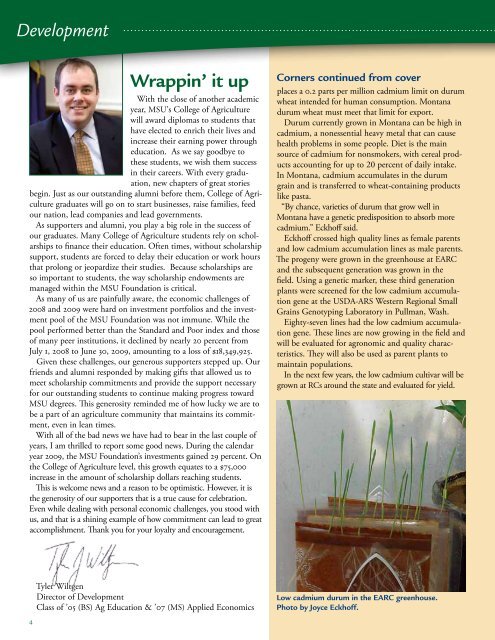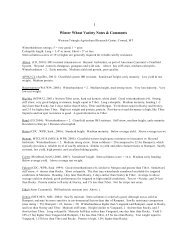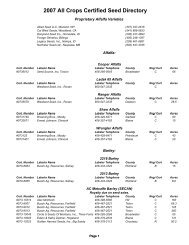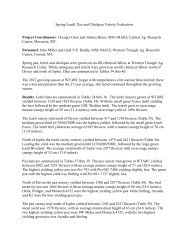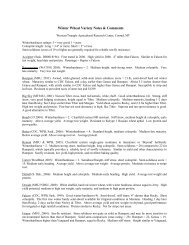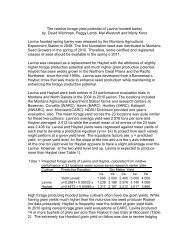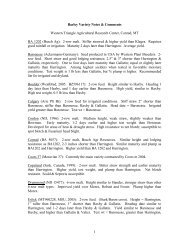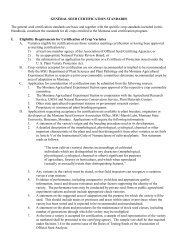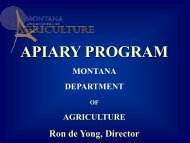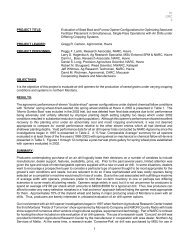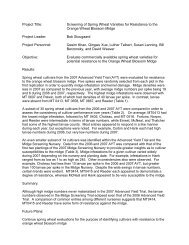Spring 2010 - College of Agriculture - Montana State University
Spring 2010 - College of Agriculture - Montana State University
Spring 2010 - College of Agriculture - Montana State University
Create successful ePaper yourself
Turn your PDF publications into a flip-book with our unique Google optimized e-Paper software.
DevelopmentWrappin’ it upWith the close <strong>of</strong> another academicyear, MSU’s <strong>College</strong> <strong>of</strong> <strong>Agriculture</strong>will award diplomas to students thathave elected to enrich their lives andincrease their earning power througheducation. As we say goodbye tothese students, we wish them successin their careers. With every graduation,new chapters <strong>of</strong> great storiesbegin. Just as our outstanding alumni before them, <strong>College</strong> <strong>of</strong> <strong>Agriculture</strong>graduates will go on to start businesses, raise families, feedour nation, lead companies and lead governments.As supporters and alumni, you play a big role in the success <strong>of</strong>our graduates. Many <strong>College</strong> <strong>of</strong> <strong>Agriculture</strong> students rely on scholarshipsto finance their education. Often times, without scholarshipsupport, students are forced to delay their education or work hoursthat prolong or jeopardize their studies. Because scholarships areso important to students, the way scholarship endowments aremanaged within the MSU Foundation is critical.As many <strong>of</strong> us are painfully aware, the economic challenges <strong>of</strong>2008 and 2009 were hard on investment portfolios and the investmentpool <strong>of</strong> the MSU Foundation was not immune. While thepool performed better than the Standard and Poor index and those<strong>of</strong> many peer institutions, it declined by nearly 20 percent fromJuly 1, 2008 to June 30, 2009, amounting to a loss <strong>of</strong> $18,349,925.Given these challenges, our generous supporters stepped up. Ourfriends and alumni responded by making gifts that allowed us tomeet scholarship commitments and provide the support necessaryfor our outstanding students to continue making progress towardMSU degrees. This generosity reminded me <strong>of</strong> how lucky we are tobe a part <strong>of</strong> an agriculture community that maintains its commitment,even in lean times.With all <strong>of</strong> the bad news we have had to bear in the last couple <strong>of</strong>years, I am thrilled to report some good news. During the calendaryear 2009, the MSU Foundation’s investments gained 29 percent. Onthe <strong>College</strong> <strong>of</strong> <strong>Agriculture</strong> level, this growth equates to a $75,000increase in the amount <strong>of</strong> scholarship dollars reaching students.This is welcome news and a reason to be optimistic. However, it isthe generosity <strong>of</strong> our supporters that is a true cause for celebration.Even while dealing with personal economic challenges, you stood withus, and that is a shining example <strong>of</strong> how commitment can lead to greataccomplishment. Thank you for your loyalty and encouragement.Corners continued from coverplaces a 0.2 parts per million cadmium limit on durumwheat intended for human consumption. <strong>Montana</strong>durum wheat must meet that limit for export.Durum currently grown in <strong>Montana</strong> can be high incadmium, a nonessential heavy metal that can causehealth problems in some people. Diet is the mainsource <strong>of</strong> cadmium for nonsmokers, with cereal productsaccounting for up to 20 percent <strong>of</strong> daily intake.In <strong>Montana</strong>, cadmium accumulates in the durumgrain and is transferred to wheat-containing productslike pasta.“By chance, varieties <strong>of</strong> durum that grow well in<strong>Montana</strong> have a genetic predisposition to absorb morecadmium.” Eckh<strong>of</strong>f said.Eckh<strong>of</strong>f crossed high quality lines as female parentsand low cadmium accumulation lines as male parents.The progeny were grown in the greenhouse at EARCand the subsequent generation was grown in thefield. Using a genetic marker, these third generationplants were screened for the low cadmium accumulationgene at the USDA-ARS Western Regional SmallGrains Genotyping Laboratory in Pullman, Wash.Eighty-seven lines had the low cadmium accumulationgene. These lines are now growing in the field andwill be evaluated for agronomic and quality characteristics.They will also be used as parent plants tomaintain populations.In the next few years, the low cadmium cultivar will begrown at RCs around the state and evaluated for yield.Tyler WiltgenDirector <strong>of</strong> DevelopmentClass <strong>of</strong> ’05 (BS) Ag Education & ’07 (MS) Applied EconomicsLow cadmium durum in the EARC greenhouse.Photo by Joyce Eckh<strong>of</strong>f.4


